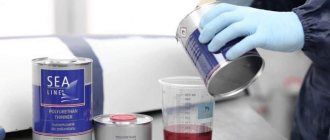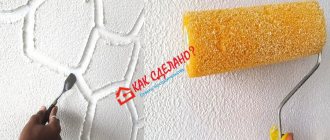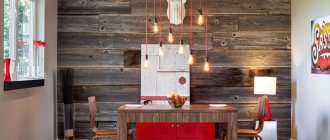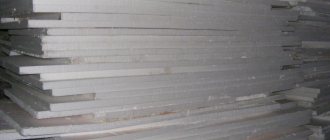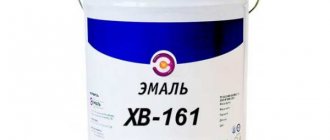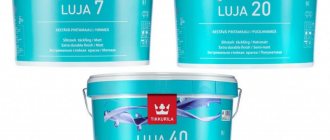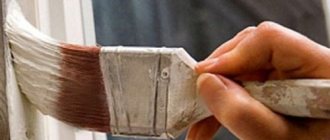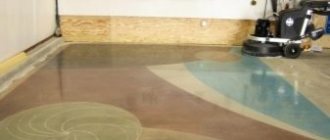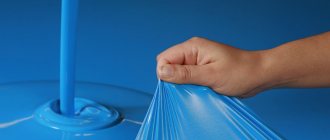Peculiarities
Polyurethane paints and varnishes represent a large group of polymers. The main components are polyols. The second component of polyurethane products are hardeners. As a result of the binding of molecules of paint components, a film is formed that is resistant to moisture, acids, various organic oils and gasoline. Therefore, polyurethane paint has a number of protective properties, due to which it resists negative atmospheric influences on the surface for quite a long time. This suspension is used for finishing indoors and outdoors, as well as for painting various structures.
The paint has a wide temperature range of use - from +150 to -40 degrees. The main features of the composition are high technical characteristics, among which are:
- adhesion equal to 2 points;
- conditional viscosity of 50-90 units;
- the presence of volatile substances in the suspension at a level of no more than 34%;
- the elasticity of the composition on the bend does not exceed 1 mm;
- The hiding power of the dry film is 75 grams/1m2.
To obtain the required color and shade, a coloring pigment is used.
What is polyurethane based paint
This group includes a large number of polymer-based decorative materials. The basic ingredients are polyols. The second important component is hardeners.
When substances bind, a film is formed that is insensitive to water, acids, organic solvents, and fuel. Polyurethane paint for metal resists corrosion and atmospheric factors. It is used to protect structures used both in open areas and indoors.
Purpose of the dye
Polyurethane enamel is designed to protect and coat surfaces. It forms a durable film on wood, concrete, and metal.
Composition and properties
The paint is made from a polymer base, dyes and hardeners. Each additive in the composition increases the strength of the decorative coating. Often such products are supplied in 2 separate packages. One contains the hardener, the other contains the resin.
After the coloring agent dries, a durable glossy coating is formed.
It highlights all the imperfections of the base, so the surface must be leveled before starting work. There are also enamels that form a matte decorative layer. It is abrasion resistant and lasts for 10 years or more.
Application area
Polyurethane compositions are intended for painting:
- walls, floors, ceilings in warehouses and retail premises;
- surfaces and structures in production shops;
- treatment facilities, swimming pools;
- agricultural implements;
- walls and floors in car washes, garages, car services.
The product can be used to protect surfaces in rooms where metals are melted.
Polyurethane floor covering.
Specifications
The finished coating can withstand temperature changes from -40...+150 °C.
Other characteristics of the finishing material include:
- adhesion, which is estimated at 2 points;
- viscosity 50-80 units;
- the amount of volatile compounds in the mixture is no more than 35%;
- the elasticity of the material at the bend is no more than 1 mm;
- The density of the finished coating is 75 g per 1 m².
Advantages and disadvantages
The widespread use of polyurethane paints is explained by the following positive characteristics:
- Increased wear resistance and strength, allowing the compositions to be used in industrial environments.
- Compatible with all types of bases. The products are suitable for processing metal, concrete, wood and stone objects. The materials adhere well to porous surfaces.
- No toxic substances released after the coating hardens. The polyurethane base is not considered harmful to humans and the environment.
- Insensitivity to aggressive factors. This increases the service life of the finished coating.
The main disadvantage is considered to be the higher cost compared to other paint and varnish products. The choice of color options is quite limited. There are few polyurethane enamels available in construction stores. It is difficult to find a product that has the required properties.
Consumption rate per 1 m2
This parameter should be taken into account when calculating the volume required for surface treatment. Buying insufficient amounts of formula will result in a repeat visit to the store. Purchasing excess paint is a waste of money. The average consumption of the mixture does not exceed 150-200 g per 1 m².
Characteristics
When performing external finishing work, polyurethane enamel is used. This enamel increases the resistance of stone types, since it creates a durable film on its surface that prevents moisture from penetrating inside.
Polyurethane paints have a wide range of applications: from household use to road markings. Two-component compositions will help create interesting effects.
After the applied composition dries, an attractive gloss appears. Unfortunately, the glossy coating emphasizes all the roughness and unevenness, so the surface must be brought to perfect smoothness in advance. There are also enamels that create a matte surface.
The painting procedure is best carried out at temperatures from minus 10 to plus 30. Air humidity does not play any role. The enamel is well applied to concrete even at a humidity close to 95%. The coating itself tolerates temperatures from minus 40 to plus 150. To get good paint adhesion, you need to prime the surface.
Polyurethane paints can be classified according to their composition and the materials for which they are intended. You can apply the paint using a brush or roller, or you can also purchase paint in a spray can.
Metal products are usually spray painted. This method of painting cars allows you to get a uniform color without drips or streaks. Concrete floors are easier to paint with a roller, but wooden surfaces are easier to paint with a brush. Different forms of release of the composition facilitate the task of painting a particular object.
Polyurethane paints are very versatile and are suitable for different types of materials. A primer is a must. This is especially true for metal surfaces.
Wooden surfaces do not need to be primed, but be sure to dry them well. Wood tends to absorb everything, so not a single layer is required. Wood paint is intended mainly for furniture and furniture production.
Those who do not know how or do not want to bother with leveling layers of paint can purchase a self-leveling version of the composition. After application, tension is formed, which ensures uniform spreading of the paint, eliminating the formation of unevenness. The method of application does not matter.
The best polyurethane paint for metal
Used to protect steel structures from corrosion and other negative factors. After polymerization is completed, the metal can be used in fresh and sea water. In this case, the service life will be calculated in years. The main thing at the painting stage is to comply with all technological features and paint each area of the surface well.
REDOX PUR (base)
Two-component polyurethane paint. Used in a system for painting steel, galvanized steel, aluminum and concrete. It is characterized by high weather resistance, inertness towards salts, chemicals, oil, gasoline, and oils. Does not turn yellow over time.
REDOX PUR (base)
The gloss level depends on the selected index:
- Redox PUR 3353 – high gloss
- Redox PUR 3355 – semi-matte
- Redox PUR 3357 – matte
The color is selected according to the RAL and Sikkens 4041 catalogs.
One liter of the finished composition is enough for 18 sq.m. in one layer up to 30 microns thick. When spraying, about a third of the composition is lost.
GRASPOLIMER PU64-P
Polyurethane primer-enamel for rust PU64-P is suitable for application to metal substrates, including rusty surfaces, in cold and sea climates. After complete polymerization, the surface is resistant to fuels and lubricants, salt, and chemical components. Recommended for protective treatment of structures used on the seashore and ships.
GRASPOLIMER PU64-P
No pre-priming of the surface is required before application due to the rust converter content. The main properties are resistance to abrasive loads, good adhesion to the base, rapid polymerization, resistance to temperature peaks from -60°C to +60°C.
The ratio of components by weight is 100:15. Thinner orthoxylene, solvent, 646. Type base + hardener. Pneumatic or airless spraying is recommended.
ZIP-GUARD
Anti-corrosion urethane paint dries quickly and goes directly over rust without priming. Made using ZIPRUST technology, which allows you to apply paint directly to rusty metal, without prior priming. Suitable for interior and exterior work on metal, wood and concrete, but not recommended for painting floors. Provides reliable and long-lasting surface protection against rust and chemical attack.
ZIP-GUARD
The composition includes petroleum distillate. Toxic.
One liter is enough for 20-23 sq.m. depending on the porosity of the base. Dries in 4 hours, complete polymerization – 24 hours.
Compound
Paint of this category is notable for the fact that it creates a strong layer on the surface being treated, protecting the material from damage. The paint is based on polymers and a homogeneous mixture of hardeners and dyes. Each element in the paint contributes to the formation of a durable, moisture-resistant coating.
Often this group of paints is sold in two separate containers, one of which contains the resin, and the other contains the hardener.
Two-component paint has advantages compared to one-component paint:
- more positive reviews than regular paint;
- moisture resistance;
- the ability to prepare the solution in portions, which ensures economical consumption of finishing material.
Polyurethane paint is suitable for covering areas exposed to destructive environmental influences. Water, acids and alkalis will not harm the coating.
Advantages and disadvantages
Their advantages of polyurethane paint for wood are:
- protection of the coating from aggressive fumes and mechanical factors;
- elasticity: after painting the surface is subject to deformation, but the integrity of the coating is not compromised;
- absence of harmful components: polyurethane has no negative effect on humans, only the solvent is dangerous, but after drying it evaporates;
- the ability to renew different surfaces - durable, loose, porous;
- ease of application;
- high drying speed;
- long lasting results.
According to reviews, it is thanks to the listed properties that the paint is in demand. The disadvantages include the high price and not a very wide selection of products. Disadvantages include the toxicity of solvents present in some products.
Advantages and disadvantages
Thanks to its unique characteristics, polyurethane paint stands above other types of paints and varnishes. There are a number of positive qualities that make the widespread use of such dyes possible.
- Excellent strength and wear resistance, thanks to which the paint is used in industry.
- Compatible with any surfaces. Compositions are purchased for processing and protecting concrete bases, metal, wooden surfaces, stone, as well as various porous materials.
- No secretions containing substances hazardous to health. This positive feature of the composition is explained by the fact that polyurethane itself is harmless.
- Resistance to the influence of aggressive environments gives coloring products the opportunity to perform their main tasks much longer than other similar products.
The disadvantages of polyurethane paint compositions include their high cost compared to other paints and varnishes, as well as a small selection of options on the market in this category. There are not many similar products on supermarket shelves, so purchasing a product with optimal characteristics can be very difficult.
How to choose a manufacturer?
The Russian market offers a wide range of polyurethane paints from domestic and foreign manufacturers. They differ significantly in composition, purpose, and functional characteristics. To make it easier to navigate the assortment, basic information on manufacturers and products is presented in table form.
| Manufacturer | Type of paintwork | Characteristics | Application |
| TeoKhim | Enamel "Elakor-PU" | high strength and wear resistance | all types of floors, wood and concrete surfaces |
| Metal paint Metal-Enamel-60, Metal-Enamel S/S | high degree of protection against corrosion and UV radiation | coating of tanks, containers, technological equipment, metal structures, metal surfaces | |
| food paint Elakor-PU “Eco” Enamel-60 | high strength resistance to chemical and intense mechanical stress | metal, wood and concrete surfaces in contact with water or food | |
| LLC "TD KRASBYT" | primer-enamel for concrete floor “Purakor” | one-component primer-enamel containing fine particles of corundum, which ensures high wear resistance and mechanical strength | concrete floors with intense mechanical load (production workshops, garages, industrial sites, warehouses, etc.) |
| primer-enamel for concrete floor “Purakor-2K” | two-component enamel of special strength with high resistance to mechanical stress and chemically aggressive environments | ||
| CJSC "ALP ENAMEL" | matte enamel “POLIURPONT TDR 20” | two-component enamel with high anti-corrosion protection, resistance to atmospheric and chemical influences | primer for concrete floors; one-layer coating for metal structures made of galvanized steel, ferrous metals, aluminum |
| "POLIURPONT TDR-50" | one-component enamel with strong adhesion to ferrous metals and metal surfaces with minor corrosion, as well as to wood and concrete | floors with high mechanical load, long-term contact with aggressive media (acids, alkalis, organics) | |
| Polytek | paint PU-2356 | two-component paint, resistant to medium-intensity mechanical loads and atmospheric influences; applied at positive temperatures in a thin layer | their floors are concrete, cement, asphalt; metal bases or structures, for interior spaces from inside and outside |
| PU-2356 | one-component paint with good resistance to average mechanical loads and any atmospheric factors; applied in a thin layer at temperatures above zero |
Marketing research shows that the most popular paints are those produced by TeoKhim, which is explained by good quality, affordable prices and a wide range. Enamels, varnishes and primers fully comply with the stated quality characteristics and meet customer expectations. A significant advantage is the wide range of applications.
Types of paints
Based on their composition, polyurethane paints are divided into two types:
- One-component – immediately containing all the necessary substances (thinners, hardeners, driers, etc.).
- Two-component - before work, requiring mixing of two components from separate containers.
Manufacturers offer several types of paint, let's figure out how they differ from each other.
Polyurethane paint based on organic solvents
Polyurethane based paint
In simple terms, this is ordinary paint modified with polyurethane.
It belongs to the type of one-component paints and consists of several components:
- Polyurethane.
- Solvent (toluene, xylene).
- Coloring pigment.
Hardening or polymerization occurs under the influence of atmospheric moisture, which reacts with the binder components included in the composition.
Important! Dry air in the room does not help the composition set, so surfaces painted with polyurethane paint should not be dried with hot air. Simply put, the higher the humidity in the room, the faster the floor will dry, and vice versa.
Numbered solvents for polyurethane
To dilute the paint, experts recommend using licensed solvents produced specifically for such coatings.
After application to the surface, one-component polyurethane paint gains strength after 48 hours. The coating becomes completely waterproof, especially wear-resistant, and resistant to aggressive environments.
Water-dispersed polyurethane paint
Water-dispersible polyurethane paint is excellent for painting baseboards and walls.
This is a one-component paint that uses plain water instead of a solvent. It has no poisonous odor and is completely harmless when painted.
The components of the mixture are evenly distributed in the aqueous medium and form a stable dispersion. As water evaporates, they gradually move closer together and then stick together upon contact. As a result, we get a thin, durable film that has both decorative and protective properties.
It is purchased mainly for painting walls in rooms with high humidity. Paint for polyurethane stucco molding or baseboards can also be water-dispersed, as it is particularly elastic and does not crack when decorative parts are bent.
Important! Since the paint contains water, it can freeze at low temperatures. After defrosting, technical indicators decrease noticeably.
Alkyd urethane paint
Alkyd-urethane enamel
This one-component paint contains the following components:
- Alkyd-urethane varnish (used to form a film).
- Drying agents for quick drying.
- Thinners.
- Pigments.
- Other targeted additives.
Using polyurethane enamel, you can create decorative and protective films with different textures and degrees of gloss. It is used for both internal and external work. For example, polyurethane floor paint based on alkyd resins can cover both the floor in the garage and paths in the yard.
Applying paint with a roller
The paint is resistant to temperature changes in the range from -60 to +60 degrees, is not afraid of moisture, has excellent abrasion resistance, and is easy to apply with a roller, brush or spray. Thanks to the driers contained in the composition, the paint dries quickly (1.5–2 hours), and when used on metal it serves as an excellent anti-corrosion agent.
Two-component polyurethane paint
Painting a metal roof with two-component polyurethane paint.
It is produced and sold in two containers - separately containing resin and hardener.
The advantages of this division are as follows:
- The ability to prepare the required amount of solution “at one time”, while the remainder does not lose its quality during further storage.
- Curing and polymerization of paint occurs without the participation of moisture.
- The coating is more durable and wear-resistant than when using one-component compounds.
Two-component polyurethane paint is used for surfaces that are particularly susceptible to negative influences. It is resistant to soluble acids, alkalis, oil, various types of fuel, and is not afraid of sea and running water, sewage.
Floor coating with polyurethane paint
Mixing the components with your own hands is done in a separate container with a construction mixer until the composition is completely homogeneous. The prepared mixture has a short lifespan (no more than 6 hours), so the consumption must be calculated in advance, otherwise the remainder will have to be thrown away.
The strength and durability of the coating directly depends on following the mixing recommendations provided by the manufacturer's instructions supplied with the paint. In addition, it indicates the number of possible layers, the type and volume of solvent, and application conditions.
Types of polyurethane paints
Depending on the composition, the following types are distinguished:
- Based on organic solvents
The most aggressive composition, but also the most durable after final polymerization. Diluted with special numbered solvents, produced together with the base coating. Final drying occurs 2 days after application. Used for internal and external work where it is necessary to achieve complete waterproofness, protection from precipitation and mechanical damage.
- Water-dispersed
Water acts as a solvent. In terms of its chemical composition, it is a completely safe material that can be used for interior work in residential buildings and apartments. Forms a thin film on the surface that is resistant to abrasion and damage. The paint is not suitable for outdoor use, as it begins to crack when the temperature drops.
- Alkyd-urethane
The base is alkyd-urethane varnish, which dries quickly and forms a durable layer. The paint does not lose color intensity even with prolonged exposure to ultraviolet radiation, but it does not protect against moisture as well as the first option. Recommended for interior and exterior, facade work, painting concrete and metal.
For ease of application, polyurethane paint is available in cans (applied with a brush or rollers) and in aerosol cans (sprayed from a distance of 40 cm).
Application methods
Polyurethane compounds are divided into groups both according to their composition and according to the materials requiring processing. Application type can be:
- aerosol;
- using a brush or roller.
Related article: Features of the use of powder paint and its types
Aerosol spraying is most often used when processing metal products. Polyurethane paint for cars provides uniform coverage without streaks or smudges. It is also an excellent alternative to conventional balloon compositions due to its safety margin.
Polyurethane paint for concrete floors is evenly distributed using a roller. The result is a smooth and even coating. But polyurethane paints on wood are best applied with a brush.
The best polyurethane paint for concrete
For painting concrete surfaces, one- and two-component compositions are used. Drying on this type of material can last from 3 days to 2 weeks. Polyurethane paint for concrete is often used to treat industrial workshops in order to extend their service life.
Polybetol
Forms a matte coating to protect concrete floors in rooms with increased mechanical loads, high humidity and constant exposure to chemically active substances. The composition is odorless, hardening occurs from air moisture.
Polybetol forms a wear-resistant, elastic and impact-resistant coating that is resistant to all loads. It has low permeability to water, petrochemicals, detergents and abrasives.
Apply a layer of up to 200 microns. Can be used at temperatures from -60°C to +100°C. Consumption is 130-160 g/m² with a thickness of 80-100 microns.
There is no need to pre-prepare the concrete base, but some experts recommend priming (Polybetol-primer) and removing dust. After priming, the base is applied only after 12 hours. It is convenient to use a squeegee or roller. It takes 12 hours for the first layer to dry. Dries in a day. Full strength gain after 5 days.
TEX Pro
High-quality alkyd-urethane enamel for painting concrete, wood and metal floors in rooms with high operational load (garages, parking lots, factories, warehouses). Perfect for outdoor floors, but under a canopy. Even if there are non-fading pigments in the composition, over time the coating loses its color intensity.
TEX Pro
One liter in 1 layer is enough to paint 8-11 m²/l, which depends on the method of application and the porosity of the base.
Before application, dilute with white spirit (up to 10% of the total mass). The drying time from dust is 10 hours, the second layer is applied no earlier than 24 hours. Complete polymerization takes a month, but after a week you can walk.
NOVBYTHIM
Wear-resistant enamel for protective painting of cement-concrete walls and floors in residential premises. Withstands significant mechanical impacts, including the movement of forklifts and cars, does not scratch, does not fade or turn yellow over time.
Among the main advantages of the paint is absolute resistance to water, salt, and petrochemicals. It has self-leveling properties; after drying, the coating is smooth, but not slippery.
Do not apply to fresh or damp concrete. Not suitable for metal. For indoor use only.
The composition includes a synthetic polymer, resins, drier (catalyst to accelerate drying), non-fading pigments and organic solvents.
Consumption when painting in two layers is 200–250 ml per m2. Drying time from dust is 2 hours, for foot traffic 12 hours, complete polymerization after 4 weeks.
What surfaces can be painted?
The materials that require processing are also different. Polyurethane paints are suitable for wood, metal and stone. It is these surfaces that most often require additional protection from external factors. The main thing to remember is the need to prime. This is especially true for metal surfaces. But sometimes floor paint for concrete falls under this rule.
And wood requires high-quality drying. In this case, you can do without a primer. At the same time, the material itself is able to absorb any compounds that are applied to it. Therefore, it is necessary to use several layers; one is not enough.
Polyurethane enamels are fully compatible with stone and adhere well to such a surface. Therefore, no primer is required in this case.
Sometimes buyers simply do not have the time to level a layer of paint with maximum accuracy, or they simply do not have the desire to do such work. Then it’s easier to use paint that levels itself.
Immediately after applying such material, so-called tension appears on the surface. It does not matter whether a roller or other device was used during application. Thanks to the tension, the paint spreads easily and all irregularities disappear.
Application rules
Wear-resistant polyurethane floor paint for wood is applied as follows:
- First, remove the old coating. This work is carried out with sandpaper or a sander.
- It is necessary to clean the surface from dust.
- If there are cracks and crevices on the surface, they are puttied.
- Apply 1 coat of paint with a roller or flat brush with natural bristles. One-component paints do not require a primer.
- The treated surface must dry. This is completed in 8 hours.
- When painting, apply 2 finishing layers.
This is how not only polyurethane paint is used for wood floors, but also compositions for other surfaces made of this material. Compliance with the sequence of work extends the life of the coating.
Review of manufacturers
Today, the building materials market offers polyurethane paints from many manufacturers. The price per jar depends on the popularity of the brand, volume and shape of the package. The most popular are German, Turkish, and Greek paints. The CIS countries produce products that are not inferior in their characteristics, and their prices are an order of magnitude lower.
Foreign trains are sold at a higher price due to the high cost of transportation and brand recognition. Domestic products undergo serious quality control and have the necessary certificates and licenses. Each type of coating has its own shelf life. It does not matter what type of coating is needed - varnish, enamel or paint. You can safely buy products from Russian brands.
Separately, it is necessary to note polyurethane paints from China. The Celestial Empire represents the largest market for paints and varnishes of any type and purpose.
Thus, paints based on complex polymers not only have a protective function and impart properties such as antistatic, impact resistance, and anti-slip properties to the surface, but also improve the appearance of the coating.
Which manufacturer should you choose?
When it comes to choosing polyurethane paints, you can safely give preference to a domestic manufacturer.
This is due to the fact that this paint and varnish coating is made from complex polymers, which are manufactured in our country and are of very good quality. Due to their unique properties, paints, enamels, and polyurethane-based primers are becoming increasingly popular. Due to the variety of different compositions, special paints are produced for concrete floors, plastics and other types of surfaces. A long service life and the highest levels of wear resistance distinguish these products from other paints presented on the modern construction market.
The best polyurethane paint for a car
Two-component. Semi-matte gloss. Contains anti-corrosion pigments. Forms a coating that protects the metal from water, prevents the spread of corrosion and leaves the coating elastic.
Glossy finish. Diluted with hardener 2:1. Dries quickly. The film is durable and elastic.
Two-component, forms a coating of increased strength. Protects against rust, corrosion, salts, mildew and extreme temperatures. Recommended for SUVs to protect the body from scratches.
The best polyurethane paint for metal
Two-component. Used in a system for painting steel, galvanized steel, aluminum and concrete. Suitable for industrial and marine environments.
Two-component oil and petrol resistant primer-enamel. Contains a rust converter. High resistance to abrasive loads. The finish is smooth and glossy.
Anti-corrosion urethane paint for metal “Zip-guard” has high adhesion to prepared surfaces: copper, bronze, stainless steel, galvanized metal and aluminum.
The best polyurethane paint for concrete
Designed to create a protective coating layer for concrete floors in rooms with high mechanical loads and exposed to aggressive chemicals.
Alkyd-urethane enamel for premises with high operational load (garages, parking lots, warehouses). Suitable for outdoor coverings under canopies and gazebos.
Wear-resistant enamel for protective painting of cement-concrete walls and interior floors. Contains synthetic polymer, resins, drier, non-fading pigments, wear-resistant fillers, organic solvents.
The best polyurethane paint for wood
Semi-gloss, jelly-like, urethane-alkyd. It is used for finishing painting of wooden surfaces indoors and outdoors.
Used to protect wooden surfaces from impacts, water, and chemicals. The composition surpasses polyurethane varnish in its properties and provides a durable, smooth transparent coating.
For wooden facades with protection against dirt. Made using Teflon Surface Protector technology, which guarantees color and structure preservation for 15 years.
What to consider when choosing?
When faced with the problem of choosing a polyurethane coating, the buyer may get confused among the huge number of options. Paints for the same purpose differ in the types and proportions of components present in the mixture. This can significantly affect the technical characteristics.
For example, there are enamels adapted to low temperatures. Consequently, there is a difference in surface requirements and application conditions. Keep in mind that the shelf life of some one-component formulations does not exceed 6 months.
Varieties and areas of application
Manufacturers produce different types of two-component formulations. Epoxy is considered the most durable, while acrylic is the most popular.
Polyurethane
Two-component paints and varnishes, which are used for painting cars, metal objects and products (garage doors, entrance doors). One semi-finished product contains polyurethane resins, the second is a hardener. Apply in 1-2 layers. The paint drying interval is usually 6-12 hours.
Advantages and disadvantages
the paint sets quickly; gains full strength 24 hours after painting; has high water resistance and resistance to mechanical loads; can be used for painting wood, plastic, concrete.
the period for painting after mixing the two components is only 1-6 hours; When connecting two parts, you must adhere to the recommended proportions, otherwise you will end up with a less durable coating.
Epoxy resin based
A two-component paintwork material consists of a semi-finished product based on epoxy resin and a semi-finished product with a hardener. Used for painting metal (copper, steel, aluminum, galvanized surfaces), car parts, truck bodies, metal containers. Can be used for painting industrial equipment.
Advantages and disadvantages
forms a strong and hard film; the coating does not allow moisture and steam to pass through; withstands any weather conditions; has anti-corrosion properties; the coating is resistant to chemicals; The paintwork hardens quickly in the open air.
has a toxic composition; The viability of the composition after mixing the two components is 3-6 hours.
Acrylic
Two-component acrylic coatings consist of two parts: a polymer acrylic semi-finished product based on resins and pigment and a semi-finished product with a hardener. Used for painting cars, metal objects, gates and doors.
Advantages and disadvantages
sets quickly; forms a durable and hard coating; after hardening, the film does not allow moisture to pass through, does not wash off, does not react to acid, gasoline, or oil; the coating is resistant to mechanical loads and elastic (does not break on bends); can be glossy or matte.
the viability of the finished mixture is no more than 3-8 hours; has a toxic composition.
Thixotropic
Two-component thixotropic coatings are available in two types: based on epoxy or polyurethane resins. Any type of semi-finished product must include a hardener. Epoxy creates a stronger and more durable coating. Used for painting metal objects and concrete surfaces.
Advantages and disadvantages
forms a hard and durable film; the painted surface can be used in conditions of high humidity; has a long protection period.
the viability of the mixture after mixing the two components is no more than 1.5-3 hours; toxic composition.
Urethane-alkyd
Two-component coatings consist of a semi-finished product based on alkyd resins and urethane esters and a hardener. Used for painting metal and wood.
Advantages and disadvantages
The paintwork sets quickly; after drying it forms a durable and hard coating; protects the surface from moisture.
toxic composition; short pot life of mixed components.
Features of two-component paints
Most often, polyurethane compounds are sold in two separate containers. One of them contains a hardener, and the other contains a resin. This type of paint can also be produced for concrete. This separation of components has its advantages:
- The ability to obtain a durable, wear-resistant coating. The characteristics are much better than those of standard formulations.
- Humidity does not affect processes such as curing and polymerization.
- It is easy to prepare the solution at once, in the required quantity. With further use, the remaining part does not lose its qualities.
A material such as acrylic paint is perfect for surfaces that are constantly exposed to negative environmental influences. There is additional protection against any acids along with solvents and alkalis. Sea and running water will also not be harmful to the composition. A construction mixer is used to mix the two paint components.
Features of application
The technique for preliminary surface preparation and paint application depends on the type of base.
The need for priming before painting
Polyurethane primer-enamel is used in the same way as other types of similar products. It does not allow the coloring composition to be absorbed into the base and provides better adhesion of materials.
The following rules are followed during the process:
- Do not apply the primer too thickly. Consumption should not exceed 180 g per 1 m². The composition is applied in several layers.
- Air sprays are not recommended. Airless application with a spray gun is allowed.
- Before staining, you need to wait at least 8 hours. The rate of polymerization of wood primer depends on the application conditions.
- Work must be carried out at a temperature of at least +20 ° C, air humidity 60-70%.
- When priming some types of wood, an insulator is added to the product, which neutralizes the effect of tannin oils.
- You need to work away from sources of fire, since the primer is considered a fire hazard.
Tools for work
When applying polyurethane enamels use:
- brushes with artificial bristles intended for applying acrylic paints;
- fur rollers with medium pile (the tool is suitable for distributing all types of dyes);
- horsehair brushes intended for epoxy-polyurethane mixtures;
- trays with ribbed sides to remove excess paint;
- squeegee;
- paint sprayer;
- grinding machine;
- high pressure washer;
- sandblasting units;
- construction vacuum cleaner.
To protect your skin, vision and breathing, you will need a work suit, a respirator, gloves, and goggles.
Tools for painting work.
General recommendations
When applying enamels, the following requirements are observed:
- the paint layer should not be too thick;
- polymerization occurs under the influence of moisture, so heat guns and air dehumidifiers cannot be installed in the room.
How to dilute
If it is necessary to liquefy polyurethane compounds, the following solvents are chosen:
- toluene;
- acetone;
- xylene;
- eluents R-5, R-4.
The thinner is added to the paint in small portions, constantly stirring the material. The appearance of bubbles or an increase in temperature indicates that the product is spoiled. Degassing of the finished mixture is not possible.
Painting the concrete base
The procedure is performed like this:
- Remove cement laitance and dust with a brush.
- Rinse the concrete base with a jet of water under pressure. Heavy contaminants, such as dried glue, are removed by sandblasting (this treatment helps to achieve the desired surface roughness). If the concrete has been painted previously, the coating is cleaned of loose particles, dust and dirt. If it is necessary to remove the old layer, wet sandblasting is performed.
- Pronounced defects are covered with a repair solution. If necessary, cracks are opened, traces of corrosion are removed from the reinforcement, and the metal is coated with a special agent.
- Apply primer. Wait until the surface is completely dry.
- Coloring begins. When working with two-component enamel, mix the base and paint hardener according to the instructions. Leave the material for 10 minutes. Stir the paint again. The finished composition is applied with a roller, brush or airless spray. Each layer is dried for 8-12 hours. It takes at least 3 days for the flooring to dry completely.
Remove dust, apply primer and paint.
Auto coverage
Painting a car with polyurethane enamel is not much different from working with other paint and varnish products.
The procedure is performed like this:
- Clean the body of dirt and remnants of the old coating. Remove traces of corrosion with a rust converter or sandpaper.
- Degrease the surface with any solvent.
- Apply a special primer for metal. The products are alcohol-based, separating, and single-component. It is advisable to use polyurethane primer. It improves the adhesion of the material to the metal and prevents corrosion. The two-component primer contains a hardener. It can be sanded, which helps create a soft surface.
- Covered with enamel. Staining is performed in 2 stages. Each layer is dried for 1-2 hours. If necessary, apply a design to the body using polyurethane enamel for an airbrush.
Advantages of polyurethane paints and varnishes
Polyurethane paint appeared on the market relatively recently, but, according to professionals, it immediately became popular. Its advantages speak in favor of choosing this paint and varnish material:
- strength;
- wear resistance;
- elasticity;
- resistance to mechanical stress;
- neutral attitude towards aggressive chemical compounds;
- high adhesion to various types of substrates (concrete, metal, wood);
- liquid structure (allows it to penetrate porous surfaces and strengthen them);
- environmental safety (can be used in children's and medical institutions).
It should be noted that polyurethane coatings retain their quality characteristics for a long time, unlike other paints and varnishes that lose their properties during operation and when interacting with an aggressive environment.
Details
Classification of one-component coatings by type of base
To classify one-component paint and varnish materials, they can be divided into 3 categories:
- Products based on organic compounds.
- Urethane-alkyd products.
- Water-dispersed suspensions.
The composition of polyurethane products of the first category, in addition to the main elements, will include toluene or xylene. To dilute such materials, special solvents are produced. The product can achieve a solid state due to the reaction of the components with moisture in the air. For this reason, the time required for this type of paint to dry perfectly will depend on the level of humidity in the indoor air. But the second type contains an alkyd-urethane varnish composition. This paint has a distinctive feature - short drying time, as a rule, it is only 1.5 hours. As a solvent for alkyd-urethane products, you need to additionally purchase white spirit.
The latter type has its name due to the solvent that is used for this product - the simplest water is required during the working process. Water-dispersed paints and varnishes are odorless and harmless to humans; when painting a surface with this composition, there is no need to use additional protective agents. They will set due to the moisture in the air. It is also necessary to take into account the fact that there are one-component compositions that have a short service life - approximately 6 months. When purchasing such paints, it will not be superfluous to pay attention to this feature.
Epoxy-polyurethane and powder paints and varnishes
You can also distinguish an additional type of polyurethane products for painting - powder-type compositions. They are produced in the form of a homogenized mixture, its components being a hardener, pigments, filler and polyester resins. This type can be classified as thermosetting coloring substances. They are used to treat the base or product, and after that they are subjected to heat treatment, which causes a reaction between the components that begin to fuse with each other. The end result of such work will be a hard and durable coating, and it is for this reason that powder formulations are most often used for work in the field of mechanical engineering. Epoxy-polyurethane paint and varnish material is highly resistant, and therefore is used in the industrial field to treat various types of structures that will come into contact with an aggressive environment, in order to provide them with an ideal level of protection.
Classification by application method
Polyurethane compounds can also be divided into several groups according to the method of application to the surface:
- Products in the form of aerosols.
- A paint and varnish composition that requires the use of a brush or roller for application.
The first group of compositions is used for surfaces and metal products. polyurethane car paint in cans will form an ideal, uniform coating that is completely free of streaks and smudges. The composition, which must be applied using painting tools (rubber/velor rollers and brushes), is mainly purchased for finishing the interior of a room. There are water-based polyurethane paints for PVC - a base coat used for industrial painting of products.
What do you usually paint cars with?
In order to decide what paint to use to paint your car, you need to understand the differences between the main and most popular types of paints. Specialists from the Katrin company, specializing in car painting in Kyiv, helped us answer the question about the main differences between acrylic and polyurethane car paint.
Paint application technique
The dyeing technology directly depends on the type of material that needs to be processed. Therefore, the technology will be considered separately.
On wooden surfaces
When work is carried out on wooden surfaces, the following steps are performed:
- The old finish is removed; for this purpose, sanding is done with sandpaper or a grinding machine.
- Afterwards, vacuum the surfaces to remove dust.
- If there are cracks and other defects, they are treated with putty.
- The first layer is applied with a roller or a brush that has natural bristles. One-component compositions do not require priming.
- Next, wait until the surface is completely dry.
- Two more layers are applied.
The first layer is applied with a roller or a brush that has natural bristles.
To metal
The process of applying polyurethane enamels to metal surfaces begins with its preparation. Includes the following steps:
- The surfaces of the machine are cleaned of all types of contaminants. Corroded areas are removed, special means are used, and sandpaper treatment is also carried out.
- The body is degreased.
- Cover the surface with a metal primer solution.
- Spray the paint onto the dry surface; apply two layers, allowing each layer to dry.
Apply two layers, each one must dry.
On concrete
The composition can also be applied to a damp surface, while the temperature in the room can remain low, down to -5 degrees. First, the concrete floor is cleaned of all dirt and dust, and a steel brush is used for recesses. If defects are found, they must be opened in order to clean the fittings and treat them against corrosion. Next, they proceed to treating the surface with special hardeners, as well as a primer solution.
There is no need to apply a thick layer of primer.
The application of the coloring agent begins when the surface is completely dry, this takes on average 8-10 hours.
The composition can also be applied to a damp surface, while the temperature in the room can remain low, down to -5 degrees.
